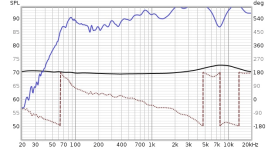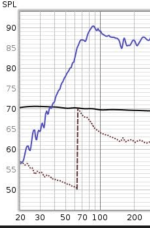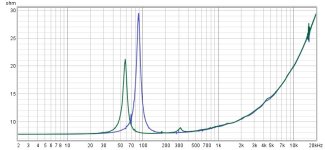This is what I got after the 12H, 100Hz treatment. Usable for the experiment if I EQ but not the best for that use case. I'll do it anyway to check that what I model is similar to what I get. Thanks for the insights!
Fs 87.8 Hz
Qms 9.181
Qes 3.295
Qts 2.425
I just started measuring drivers, but the measurements haven't been too off when checking drivers with specs.
---
Simulated in 200Lt box.

Mounted in a box with the back open, from 15cm. Only adding because it's better than the previous one.

Fs 87.8 Hz
Qms 9.181
Qes 3.295
Qts 2.425
I just started measuring drivers, but the measurements haven't been too off when checking drivers with specs.
---
Simulated in 200Lt box.
Mounted in a box with the back open, from 15cm. Only adding because it's better than the previous one.
Attachments
-
 6x9_delco_no_tweeter_after_100Hz.png66.4 KB · Views: 64
6x9_delco_no_tweeter_after_100Hz.png66.4 KB · Views: 64 -
 1689555702474.png93.1 KB · Views: 56
1689555702474.png93.1 KB · Views: 56 -
 1689555626247.png6.5 KB · Views: 48
1689555626247.png6.5 KB · Views: 48 -
6x9_sin_tapa_after_100Hz.mdat1.8 MB · Views: 56
-
6x9_delco_no_tweeter_after_100Hz.txt748 bytes · Views: 61
-
 6x9_sin_tapa_after_100Hz_impedances.mdat.jpg63.5 KB · Views: 59
6x9_sin_tapa_after_100Hz_impedances.mdat.jpg63.5 KB · Views: 59
But every car loudspeaker designed to be mounted in doors or behind the rear seats has Qts equal or greater than 1. And I mean every loudspeaker, including 6x9".
I found an old issue of Car Stereo Review today, where they tested 8 different 6x9's. In their testing, they measured T/S parameters in their lab and here are the numbers.
Notice that not a single one has a Qts that's out of HiFi driver range, and average Fs is 52Hz.
Notice that not a single one has a Qts that's out of HiFi driver range, and average Fs is 52Hz.
Because of your table I checked these JBL car speakers. They sell the 939 here. Nice to see the lower Qts, also more than 10x the price of the ones I tested 🙂
Not shopping for car speakers now. But that one looks cool. Fb 33Hz in a 114 l box.
Old issue. Old drivers. Many years ago.I found an old issue of Car Stereo Review today, where they tested 8 different 6x9's. In their testing, they measured T/S parameters in their lab and here are the numbers.
I am talking about the current production.
Old issue. Old drivers. Many years ago.
That is True.
And this statement can easily be true:
"any car speakers that I've tested have Qts equal or greater than 1",
These statements are all possibly true:
"many car speakers have Qts equal or greater than 1",
"many cheap car speakers have Qts equal or greater than 1",
"many factory car speakers have Qts equal or greater than 1", or
"many new aftermarket car speakers have Qts equal or greater than 1"
But this:
Is not.But every car loudspeaker designed to be mounted in doors or behind the rear seats has Qts equal or greater than 1. And I mean every loudspeaker, including 6x9".
I'm sorry for flogging this horse, but people come here for help. Testing (which I applaud) a small sample and then stereotyping a vast and varied population based on that sample doesn't hold up to scrutiny.
Fortunately, @lene looked around some more and found current products encouraging, with parameters in between our examples, two posts back.
Just for posterity, here are some current model car drivers with parameters one would expect in good quality components designed for door or trunk mounting.
https://stereointegrity.com/product/tm65-mkiv-midbass/
https://stereointegrity.com/product/m3-carbon-midrange/
https://www.parts-express.com/Lanza...-400-Watt-Midbass-Speaker-292-2598?quantity=1
https://www.parts-express.com/DS18-...ant-Coaxial-Speaker-4-Ohm-294-8046?quantity=1
My point of all this being:
Dear readers: do plenty of your own research, don't take the word of any one person online (that includes me) as gospel unless you are sure of their qualifications and what they're been drinking when they posted, and test it for yourself if you can.
This statement also can easily be true:
"all car drivers (in-door and 6x9") I tested and measured have Qts=1 or above".
Surprise, surprise: it is true!
This statement also can easily be true:
"Qts parameters in many datasheets are way smaller than the real measured Qts".
Surprise, surprise: it is true!
"all car drivers (in-door and 6x9") I tested and measured have Qts=1 or above".
Surprise, surprise: it is true!
This statement also can easily be true:
"Qts parameters in many datasheets are way smaller than the real measured Qts".
Surprise, surprise: it is true!